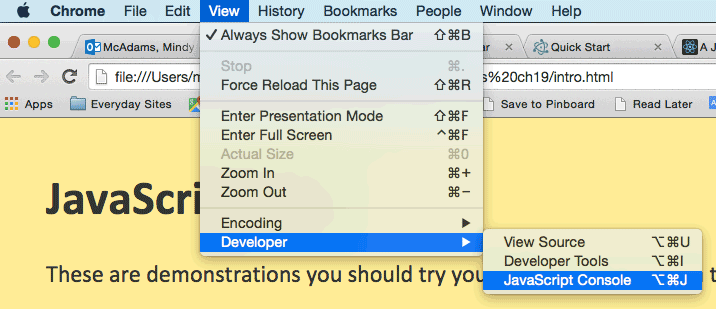These are demonstrations you should try yourself. In Chrome, open the View menu, go to Developer, go to JavaScript Console.

Make sure the option Console at the far right is selected. Now you have a command line where you can practice JavaScript.

Type one line into the Console and press Return/Enter. Do not skip any lines.
alert("Hello, World!");
var fruit = "apple";
alert(fruit);
alert("The fruit is " + fruit);
fruit = "orange";
alert("The fruit is " + fruit);
fruit = 42;
alert("The fruit is " + fruit + ".");
Note: Only use the var keyword the FIRST time, when you declare the variable. After that, you are assigning a new value to the variable that already exists.
var color;
alert("The color is " + color);
color = null;
alert("The color is " + color);
color = 10 + 5;
color = 10 - 5;
color = 50 * 3;
color = 50 / 5;
Two forward slashes create a comment. A line that begins with // will not be executed.
// not a number
color = 10 / "foo"
// number vs. string
color = 10 + "5";
color = "blue";
alert("The color is " + color);
// concatenation
color = color + color;
alert("The color is " + color);
color = color + color;
alert("The color is " + color);
Some numbers must be strings!
var socialSecurity = "321-89-4567";
var officePhone = "352-392-3261";
var zipCode = "32611";
No alert() here -- just type into the Console one line at a time.
var animal1 = "cat";
var animal2 = "dog";
animal1 == animal2;
animal1 != animal2;
var cats = 6;
var dogs = 3;
cats > dogs;
cats < dogs;
var six = "6";
// true
cats == six;
// false
cats === six;
Can you determine the difference between == and ===? It's important.
var cat = "black";
if (cat == "black") alert("The cat is black!");
// nothing
if (cat != "black") alert("The cat is not black!");
// works
if (cat != "white") alert("The cat is not white!");
cat = "ginger";
Note: To make the following if/else block work, you'll need to copy all five lines and PASTE into the Console.
if ( cat == "black" ) {
alert("The cat is black!");
} else {
alert("The cat is not black!");
}
var fruits = ["grapes", "apples", "oranges", "cantaloupes"];
alert(fruits);
alert(fruits[1]);
alert(fruits[0]);
alert(fruits[2] + fruits[3]);
alert(fruits[2] + " and " + fruits[3]);
fruits[2] = "lemons";
alert(fruits);
Note: To make each of the following work, you'll need to copy a whole three-line block and PASTE it into the Console.
for ( var i = 0; i <= 50; i += 10 ) {
console.log(i);
}
for ( var i = 50; i >= 0; i -= 10 ) {
console.log(i);
}
Compare the two for statements above to the two below:
for ( var i = 0; i <= 10; i++ ) {
console.log(i);
}
for ( var i = 10; i >= 0; i-- ) {
console.log(i);
}
Now use an array:
var fruits = ["grapes", "apples", "oranges", "cantaloupes"];
for ( var i = 0; i < fruits.length; i++ ) {
alert( fruits[i] );
}
Here is a different format for looping through an array. It produces the same output as the previous example.
for ( var i in fruits ) {
alert( fruits[i] );
}
Use of i for the variable name is not required. This works exactly the same way as the previous example.
for ( var fruit in fruits ) {
alert( fruits[fruit] );
}
Next: JavaScript Functions
Published under an MIT License. Copyright © 2015 Mindy McAdams. Fork on GitHub.